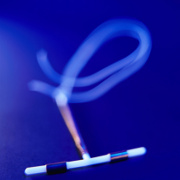 Photo: Getty Images
Photo: Getty Images
Looking for a birth control method that doesn’t involve injections or pills? Consider an intrauterine device (IUD). These nifty little "T-shaped" devices are inserted up into the uterus where they can remain for five to 10 years, depending on the kind you choose. There are two types, one with the hormone progestin, called a Mirena, and the other is wrapped in copper (no hormones) and called a Paragard.
IUD’s are generally inserted in an office visit without the need for any anesthesia. First, a speculum is inserted (just like during your Pap), then a small tube containing the IUD tucked inside is inserted up into your uterus through your cervix. Once in the appropriate place, the IUD is gently pushed out of the tube and the tube is removed. The IUD is attached to strings that hang slightly outside of your cervix for removal purposes. Most women never feel the IUD or strings once in place. The insertion can cause some cramping and you may feel cramping afterward while your body is getting used to the idea of an IUD up inside. Some women are concerned about the IUD escaping and floating around the abdominal cavity, but this won’t occur as the openings to your fallopian tubes are so tiny, the IUD could never fit.
The Paragard does not have any hormones and instead utilizes the copper to immobilize sperm trying to make its way up to the egg. Should a sneaky sperm get by, the copper causes mild inflammation to the area making implantation virtually impossible. The Paragard has a 99 percent protection rate against pregnancy and can remain inside for 10 years. The biggest side effect to the Paragard is the "adjustment stage" where it might take a few months of heavier menstrual bleeding and increased cramps until things normalize.
The Mirena has progestin, which is the synthetic progesterone hormone that is slowly released over a period of about five years. The progestin thins the lining of the uterus (called the endometrium) to a point where many women have a much reduced blood flow during their menstrual cycle, or don’t bleed at all. Because of this, many women choose the Mirena if they have a history of heavy bleeding or cramps as the progestin can provide relief.
Removing an IUD is quite simple. Your health care provider inserts a speculum again and then uses large tweezers, so to speak, to grab onto the strings and pull. As the IUD is "T-shaped", the "T" part of it bends upwards and the IUD slides out.
If you are having a difficult time with birth control pills, rings, or injections, or are looking for an option to help your heavy periods, talk with your health care provider about the IUD.
References:
1. www.mirena-us.com
2. www.paragard.com
Reviewed May 25, 2011
Edited by Alison Stanton






Add a Comment1 Comments
Thanks for these informations .but i want to know after removing mirena can i get pregnant directly or i need long time
February 20, 2012 - 12:43pmThis Comment